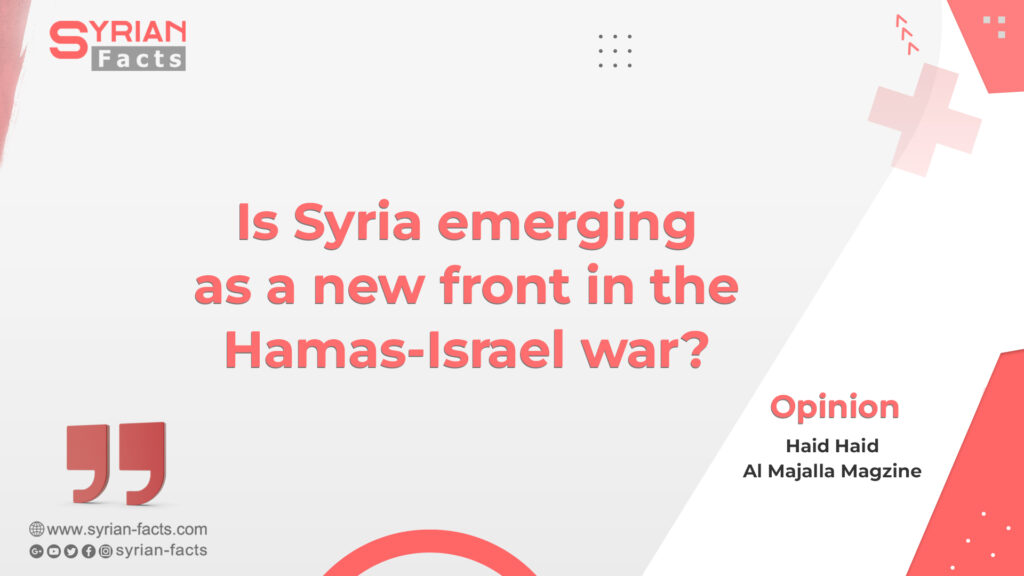The Israeli military crippled Syria’s Aleppo airport on Saturday, mere hours after it had resumed operations following a prior bombardment.
Earlier that day, Israel shelled Syria in response to a rocket fired from the southern region towards the occupied Golan Heights. This escalation does not come as a total surprise, as Iranian-backed forces have been mobilised and deployed along the Syria-Israel border since 9 October.
Yet, these unfolding developments have raised critical questions regarding the potential use of Syria to create a new front as Israel’s ongoing offensive in Gaza intensifies. This concern is amplified by the fact that Israel has engaged in tit-for-tat exchanges with Hezbollah in southern Lebanon.
While the Syrian regime may not possess the necessary resources or willingness to embark on such a risky endeavour, the presence of multiple Iranian-backed forces in Syria, including Hezbollah and the Iraqi popular mobilisation militias, opens the door for others to make that call, especially if hostilities on other fronts continue to escalate.
The Syrian government’s response has primarily focused on issuing official statements condemning Israel, alongside consultations with regional and international stakeholders to de-escalate the situation. Despite refraining from using overtly threatening language, Syria’s frontlines with Israel have not remained calm.
On the evening of 10 October, mortar rounds were launched from Syria toward the Golan Heights, which have been under Israeli occupation since 1967. Israel swiftly retaliated with artillery fire directed towards the source of the attack.
Israel attacks Syrian airports
Two days later, Israel conducted simultaneous missile attacks on Syria’s main airports in Damascus and Aleppo, rendering both non-operational.
Sources suggest that in addition to disrupting Iranian weapon supply routes to Syria, this strike, which coincided with the planned visit of an Iranian foreign official to Syria, may have served as a warning to Iran against potential interference through Syria and Hezbollah in Lebanon.
However, another missile attack was reportedly launched from Syria on 14 October, provoking a subsequent Israeli strike on Aleppo airport just as it had resumed operations.
Notably, no group has officially claimed responsibility for the missile attacks against Israel, and even the Syrian state news agency refrained from reporting the incident. Nevertheless, sources indicate that both missile attacks were likely carried out by a Palestinian group affiliated with Hezbollah.
Limited scale of skirmishes
The limited scale of these skirmishes indicates that they are utilised to deliver political messages through military means. Iran aims to emphasise that the Syrian regime’s reluctance to engage in military action against Israel directly does not imply that other armed factions operating in the region cannot take such action.
This is especially significant considering that the non-Syrian militias operating there receive their directives from Iran rather than Damascus.
On the other hand, Israel has employed its retaliatory actions to illustrate that its ongoing conflict in Gaza has not hampered its ability to disrupt Iran’s attempts to transfer strategic weaponry to Syria or via Syria. Additionally, Israel aims to demonstrate its readiness to engage on multiple fronts and respond beyond its borders if provoked.
Unfortunately, the situation is unlikely to de-escalate, but predicting its unfolding remains challenging. At present, reciprocal targeting along the Syrian-Israeli frontlines remains the most probable scenario.
These limited incidents would enable Iran and its proxies to maintain their appearance of taking actions in support of Palestinian resistance without becoming entangled in an undesirable conflict with Israel.
Another objective these skirmishes might serve is to keep Israeli forces stationed along the Syrian border occupied and impede their deployment to engage in Gaza. To that end, the frequency of these attacks may increase as the fighting in Gaza intensifies.
It is worth mentioning that these limited skirmishes will not necessarily be limited to targeting Israel. The Iraqi Popular Mobilisation Forces have recently threatened to target American assets in the region, including Syria, if the US intervenes in the Hamas-Israel war—or if Tel Aviv “expands the battleground.”
US also warned
The likelihood of a larger military confrontation with Israel originating from Syria remains relatively low. However, if it were to occur, it would likely be prompted by Israeli escalations against Hezbollah in Lebanon.
The ongoing back-and-forth exchanges between Tel Aviv and Hezbollah have, for the most part, adhered to the established rules of engagement between the two parties. Nevertheless, with both Hezbollah and Israel emphasising retaliation for every attack and signalling their readiness to push the boundaries, unintended escalation remains a possibility.
The likelihood of such developments increases in an environment of heightened pressure, driven by the escalating Israeli-Gaza conflict, the potential for a collapse in Hamas’s resistance, and the rising number of Palestinian casualties. Such a development could lead to similar escalations on other fronts in Syria, Iraq, and Yemen.
In either scenario, Syria will persist as a battleground where other countries, chiefly Iran and Israel, engage in remote conflict. While the Syrian people’s steadfast support for Palestine remains unshaken, being used as pawns in these conflicts is not how they would choose to express their solidarity.
Al Majalla Magzine





Be the first to write a comment.